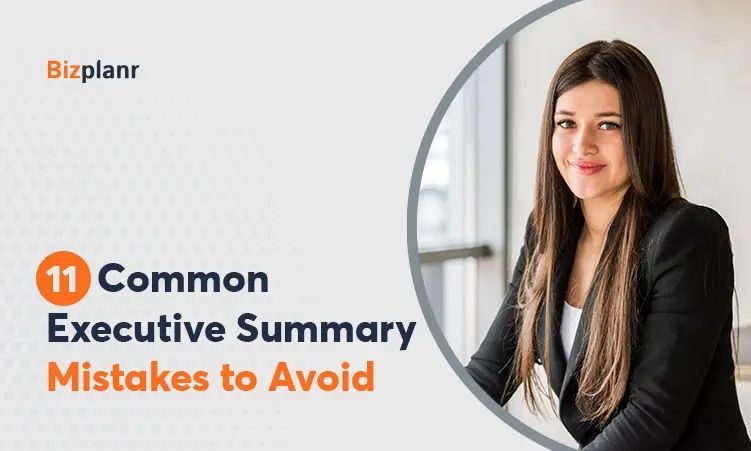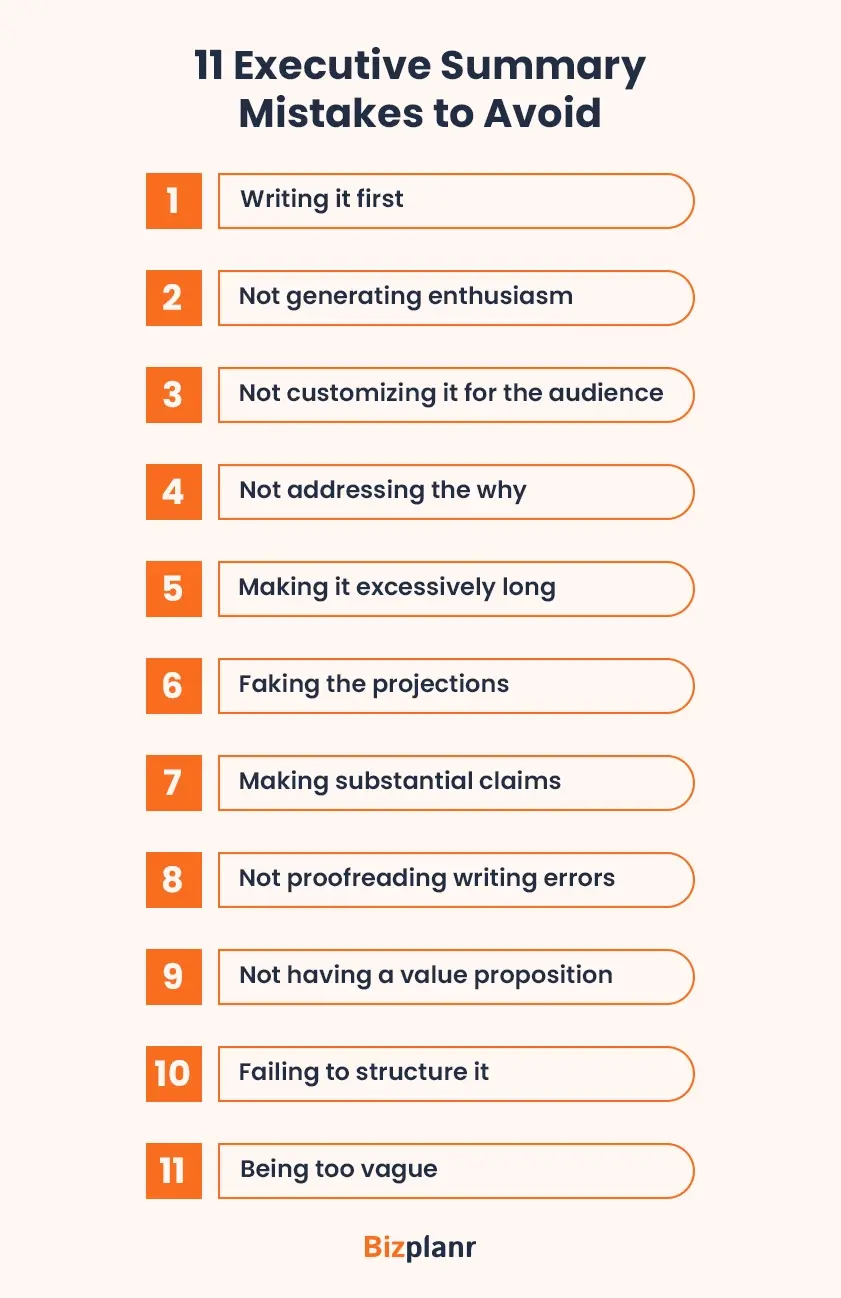An executive summary is the first point of contact between readers and the business plan.
Failing to make the first impression means you lose your only chance to convince the reader.
Thankfully, you can craft effective summaries when you know what executive summary mistakes you should avoid.
In this blog post, we will uncover those mistakes and also suggest ways to fix them.
Let’s dive right in.
11 Common Mistakes to Avoid While Writing an Executive Summary
Let’s review the most common executive summary mistakes and get tips and insights to correct them.
Mistake 1: Writing it first
Just because an executive summary is placed at the beginning, doesn’t mean you write it first.
Remember, an executive summary is simply a condensed and synthesized version of your plan.
Writing it at the end will help you capture the essence of your business plan ensuring you don’t leave behind any important information.
To offer an overview, here are the aspects your executive summary should touch:
- Purpose of this plan
- Business objectives
- What’s in for the readers
- Product and services
- Business strategy
- Financial Outlook
- People in the team
- Funding demand
Mistake 2: Not generating enthusiasm
Most executive summaries fail to convey the excitement and passion for the business. If that’s the case, readers won’t read further.
Use your executive summary to highlight how your business is unique and exciting. Instead of a robotic monotonous script, adapt a storytelling approach and weave different elements of your plan coherently.
Most importantly, make sure that you give readers a persuasive purpose and reason to keep reading further.
Mistake 3: Not customizing it for the audience
Another prominent mistake most entrepreneurs make is using the same executive summary for all audiences. Well, this won’t help you establish relevance.
While crafting an executive summary, it’s important to understand what your readers are and what they care about. A summary should address the needs of your readers and highlight the information that appeals to them.
Most importantly, it should be in a tone and language that resonates with your audience. For instance, a professional persuasive tone works best for investor plans.
Mistake 4: Not addressing the why
If a summary fails to articulate the real-world issue it’s resolving, that’s a major miss. No investors would give it a second chance.
“Most executive summaries offer a high-level overview without answering the questions I think of while reading the summary.” Michael Needham, Chief Content Officer of Finturf said so when we interviewed him.
According to him, great writing should always answer the reader's questions. Think about the questions you’re putting in the reader's mind and then be sure to answer them in your summary.
If you fail to do so, you won’t build credibility and trust for your business.
Mistake 5: Making it excessively long
Executive summaries are supposed to be comprehensive. Making your summaries excessively long will only bore your readers. However, that doesn’t mean you cram too much information into this section.
Instead, learn how to strike a balance between detailing and brevity. Distill important information and synthesize it crisply in your summary.
Ideally, a 1-2 page summary broken into smaller and engaging text blocks makes it easy to digest and scan.
Mistake 6: Faking the projections
There’s no need to butter the investors with overly ambitious projections. Most seasoned investors would take no more than a second to spot unrealistic projections and flag you out. So make sure you’re as realistic as possible.
Moreover, don’t skimp on the financial details. Be it your funding demands or revenue projections, be clear about your intentions and add enough data to help investors gauge the financial sustainability of your business.
Mistake 7: Making substantial claims
Always verify the claims you make and if you can’t don’t make any. That’s because when the reader catches you making false statements, nothing you say any further would make a difference.
This insight by John Pennypacker, the VP of sales and marketing at Deep Cognition will help you understand better.
“While reviewing a summary once, a business stated $50M of the total addressable market. Being aware of the market space, I instantly sensed something was amiss. Upon reviewing the details, I found that their calculations also included tangentially related industries.
This was it for me. If a business can’t understand its market space how can I expect it to survive? I couldn’t bring myself to trust this company again.”
The crux is, don’t ever try to fool the readers. If you have some claims to make, always back it up.
Mistake 8: Not proofreading writing errors
All it takes is a couple of minutes to screen and review your summary for any spelling and grammatical errors. While it may not seem like a pressing issue, most readers flag a misspelled word or an obvious grammar error as an instant turn-off.
Run your summary through Grammarly or ChatGPT before adding your final draft to the plan. To add another layer of quality check; ask a friend, a colleague, or someone more experienced. They can offer an unhinged and fresh perspective and can help identify the missing gaps in your summary.
Mistake 9: Not having a value proposition
Talk about your product and service offerings. However, don’t make your summary all about it.
Most entrepreneurs answer the what about the business but fail to address the why for the investors. Investors tend to turn down such proposals when they can’t see a clear value proposition for themselves.
Demonstrate how your business is a good venture for them to invest in or how partnering with your business will be beneficial for the stakeholders.
Mistake 10: Failing to structure it
Just like your business plan, your executive summary should also be well-structured and formatted. Adding dense text blocks will scare the readers away, no matter how naturally your summary flows. It will also dilute the impact you wish to create for the readers.
So keep your paragraphs short and focused. Organize the information through headings and bullet points. If possible add visuals to convey complex aspects simply.
Mistake 11: Being too vague
Executive summaries should be contextual. It’s an instant turn-off for the readers when you try to make it fancy and extremely wordy. Adding jargon, buzzwords, and stuffed phrases to your summary makes it even worse.
So avoid being superficial. Use simple language and don’t try to beat around. Make your summary contextually rich.
Craft better executive summaries with Bizplanr
Since an executive summary is the first impression, there’s no room for you to make any mistakes. And even with double or triple quality checks, you may miss out on something crucial or embarrassingly simple.
Worry not. You can always reduce the number of reviews and errors with Bizplanr’s AI-powered business plan generator. It can craft compelling executive summaries for your business (the one that answers the whys, has a clear purpose, is short, and addresses all the key aspects) in about 10 minutes. The most important of all—it’s free.
Get Your Business Plan Ready In Minutes
Answer a few questions, and AI will generate a detailed business plan.
Frequently Asked Questions
What are the most critical elements of an executive summary?
Here are the most crucial aspects that all the executive summaries should include:
- Purpose of this plan
- Business objectives
- What’s in for the readers
- Product and services
- Business strategy
- Financial Outlook
- People in the team
- Funding demand
How long should an executive summary be?
An executive summary should ideally be between 1-2 pages long. Anything longer than that can risk your reader’s attention.
Can you use bullet points in an executive summary?
Absolutely. Using bullet points and headings in your summary can help organize the information structurally and logically.
What are the biggest mistakes to avoid in an executive summary?
Here are some of the biggest executive summary mistakes that will instantly scare the readers away:
- Too vague and complicated
- Not having a clear value proposition for the readers
- Extremely long and textually dense
- Insubstantial financial and business claims
- Lacking key information
- Grammatically unsound






